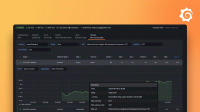Caution
Grafana Alloy is the new name for our distribution of the OTel collector. Grafana Agent has been deprecated and is in Long-Term Support (LTS) through October 31, 2025. Grafana Agent will reach an End-of-Life (EOL) on November 1, 2025. Read more about why we recommend migrating to Grafana Alloy.
This is documentation for the next version of Agent. For the latest stable release, go to the latest version.
remotecfg block (beta)
remotecfg is an optional configuration block that enables Grafana Agent Flow to fetch and load the configuration from a remote endpoint.
remotecfg is specified without a label and can only be provided once per configuration file.
The API definition for managing and fetching configuration that the remotecfg block uses is available under the Apache 2.0 license.
BETA: The
remotecfgenables beta functionality. Beta features are subject to breaking changes, and may be replaced with equivalent functionality that cover the same use case.
Example
remotecfg {
url = "SERVICE_URL"
basic_auth {
username = "USERNAME"
password_file = "PASSWORD_FILE"
}
id = constants.hostname
metadata = {"cluster" = "dev", "namespace" = "otlp-dev"}
poll_frequency = "5m"
}Arguments
The following arguments are supported:
| Name | Type | Description | Default | Required |
|---|---|---|---|---|
url | string | The address of the API to poll for configuration. | "" | no |
id | string | A self-reported ID. | see below | no |
metadata | map(string) | A set of self-reported metadata. | {} | no |
poll_frequency | duration | How often to poll the API for new configuration. | "1m" | no |
If the url is not set, then the service block is a no-op.
If not set, the self-reported id that the Agent uses is a randomly generated,
anonymous unique ID (UUID) that is stored as an agent_seed.json file in the
Agent’s storage path so that it can persist across restarts.
The id and metadata fields are used in the periodic request sent to the
remote endpoint so that the API can decide what configuration to serve.
Blocks
The following blocks are supported inside the definition of remotecfg:
| Hierarchy | Block | Description | Required |
|---|---|---|---|
| basic_auth | basic_auth | Configure basic_auth for authenticating to the endpoint. | no |
| authorization | authorization | Configure generic authorization to the endpoint. | no |
| oauth2 | oauth2 | Configure OAuth2 for authenticating to the endpoint. | no |
| oauth2 > tls_config | tls_config | Configure TLS settings for connecting to the endpoint. | no |
| tls_config | tls_config | Configure TLS settings for connecting to the endpoint. | no |
The > symbol indicates deeper levels of nesting.
For example, oauth2 > tls_config refers to a tls_config block defined inside an oauth2 block.
basic_auth block
| Name | Type | Description | Default | Required |
|---|---|---|---|---|
password_file | string | File containing the basic auth password. | no | |
password | secret | Basic auth password. | no | |
username | string | Basic auth username. | no |
password and password_file are mutually exclusive, and only one can be provided inside a basic_auth block.
authorization block
| Name | Type | Description | Default | Required |
|---|---|---|---|---|
credentials_file | string | File containing the secret value. | no | |
credentials | secret | Secret value. | no | |
type | string | Authorization type, for example, “Bearer”. | no |
credential and credentials_file are mutually exclusive, and only one can be provided inside an authorization block.
oauth2 block
| Name | Type | Description | Default | Required |
|---|---|---|---|---|
client_id | string | OAuth2 client ID. | no | |
client_secret_file | string | File containing the OAuth2 client secret. | no | |
client_secret | secret | OAuth2 client secret. | no | |
endpoint_params | map(string) | Optional parameters to append to the token URL. | no | |
proxy_url | string | HTTP proxy to send requests through. | no | |
no_proxy | string | Comma-separated list of IP addresses, CIDR notations, and domain names to exclude from proxying. | no | |
proxy_from_environment | bool | Use the proxy URL indicated by environment variables. | false | no |
proxy_connect_header | map(list(secret)) | Specifies headers to send to proxies during CONNECT requests. | no | |
scopes | list(string) | List of scopes to authenticate with. | no | |
token_url | string | URL to fetch the token from. | no |
client_secret and client_secret_file are mutually exclusive, and only one can be provided inside an oauth2 block.
The oauth2 block may also contain a separate tls_config sub-block.
no_proxy can contain IPs, CIDR notations, and domain names. IP and domain
names can contain port numbers. proxy_url must be configured if no_proxy
is configured.
proxy_from_environment uses the environment variables HTTP_PROXY, HTTPS_PROXY
and NO_PROXY (or the lowercase versions thereof). Requests use the proxy from
the environment variable matching their scheme, unless excluded by NO_PROXY.
proxy_url and no_proxy must not be configured if proxy_from_environment
is configured.
proxy_connect_header should only be configured if proxy_url or proxy_from_environment are configured.
tls_config block
| Name | Type | Description | Default | Required |
|---|---|---|---|---|
ca_pem | string | CA PEM-encoded text to validate the server with. | no | |
ca_file | string | CA certificate to validate the server with. | no | |
cert_pem | string | Certificate PEM-encoded text for client authentication. | no | |
cert_file | string | Certificate file for client authentication. | no | |
insecure_skip_verify | bool | Disables validation of the server certificate. | no | |
key_file | string | Key file for client authentication. | no | |
key_pem | secret | Key PEM-encoded text for client authentication. | no | |
min_version | string | Minimum acceptable TLS version. | no | |
server_name | string | ServerName extension to indicate the name of the server. | no |
The following pairs of arguments are mutually exclusive and can’t both be set simultaneously:
ca_pemandca_filecert_pemandcert_filekey_pemandkey_file
When configuring client authentication, both the client certificate (using
cert_pem or cert_file) and the client key (using key_pem or key_file)
must be provided.
When min_version is not provided, the minimum acceptable TLS version is
inherited from Go’s default minimum version, TLS 1.2. If min_version is
provided, it must be set to one of the following strings:
"TLS10"(TLS 1.0)"TLS11"(TLS 1.1)"TLS12"(TLS 1.2)"TLS13"(TLS 1.3)



